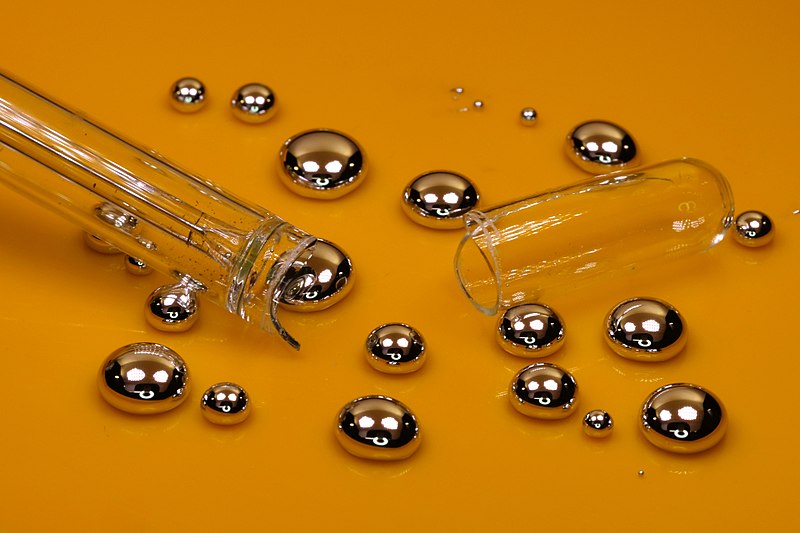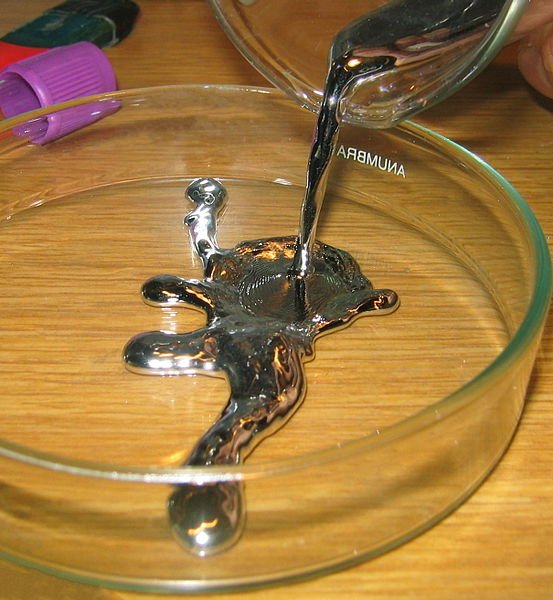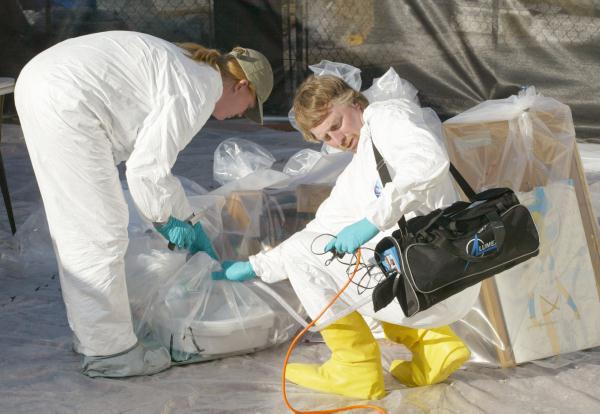Mercury and its daily use.
Mercury is a highly volatile metal, which once poured into the atmosphere, can be transported over long distances. When the mercury is poured into the water, it is converted into an organomercury, which are usually neurotoxins, compounds that can be accumulated in fish, animals, and humans. In the environment, mercury never disappears, thus ensuring present and future contamination. Atomic number 80 and with position 80 in the periodic table. Its symbol is Hg and belongs to the group of transition metals and its usual state in nature is liquid.
Liquid mercury evaporates easily in the air, even at room temperature, to form mercury vapor (in gas).

Image Source:commons.wikimedia.org
CC- BY-4.0
The most popular use of mercury is in thermometers, barometers, diffusion pumps and, to a lesser extent, in electric gears. Even in our days, despite the dangers to health, many batteries and fluorescent tubes are made with mercury as a component. The production of chlorine and caustic soda, products for dentistry, paints, pesticides and chemical catalysts, among other things, also contain certain amounts of mercury.
What happens if you touch the mercury?
Some thermometers and light bulbs contain small amounts of mercury. If one breaks, it is unlikely to cause health problems. However, contact with mercury should be avoided, and special care should be taken when cleaning it.
Mercury is a highly toxic element and can be found in the form of metal, such as organic mercury or as mercury salts. We can find it in our homes in countless artifacts such as thermometers, barometers, and fluorescent bulbs. That is why, when one of these artifacts is broken, we are exposed to a significantly high amount of mercury.
Among the health problems that can cause, you can mention vomiting, diarrhea, damage to brain functions, allergic reactions, headache, irritation in the lungs, fatigue, birth defects, miscarriages and damage to the nervous system among others.

Image Source:commons.wikimedia.org
CC- BY-3.0
How to clean mercury.
It is wise to take special care when cleaning mercury. Here are some tips to help you do this by avoiding touching mercury:
Ventilate the room, for example, by opening the windows. Leave them open for at least 15 minutes.
Leave the room while it is being ventilated, keeping children and pets out.
Wear rubber or plastic gloves and change clothes (wear old clothes) before cleaning mercury droplets and broken glass.
Collect pieces of glass carefully, and put them in a plastic bag or container.
Collect spilled mercury droplets using a piece of cardboard or a strip of masking tape.
Mercury droplets reflect light, so a flashlight can be used to search for drops that are difficult to detect.
Put all the used material that you have touched the mercury in the plastic bag, with the drops of mercury also.
Clean the area with a damp cloth. Put the cloth in the same bag and seal it.
Leave the room and ventilate for at least 24 hours after cleaning the spilled mercury.
The town halls offer facilities where hazardous waste can be disposed of, such as local councils and recycling centers.
Mercury spills on absorbent surfaces, such as carpets and upholstery, can be difficult to clean. In these cases, it is advisable to contact the environmental health department of each municipality. The affected areas may need to be removed and eliminated.
.jpg)
Image Source:commons.wikimedia.org
Public Domain
Courtesy of the Environmental Protection Agency
What should not be done with mercury.
Mercury is dangerous because of its vapor pressure, which is relatively high. The mercury vapor is absorbed in the lungs, dissolves in the blood, and is transported to the brain, where it causes great irreversible damage to the central nervous system. Metal mercury is also slightly soluble in water, due to its weak metal bonds. The escape of metallic mercury from electrolytic chlor-alkali plants leaking into nearby rivers has caused significant pollution problems.
When cleaning up a mercury spill:
Do not put the sealed bag in the wastebasket of households, since mercury is classified as hazardous waste.
Do not touch the mercury with your bare hands.
Do not use a vacuum cleaner.
Try not to generate dust, but if there is any dust, avoid breathing.
Do not throw the mercury down the drain or drain.
Do not sweep the mercury with a brush.
Do not wash clothes that have touched the mercury in a washing machine. It should be placed in a sealed bag and disposed of.
Symptoms of mercury poisoning.
Although mercury is poisonous (toxic), it usually only causes problems if large amounts of it are inhaled.
Very little mercury is absorbed by the body if a small amount of liquid mercury is ingested, or enters the skin for a short time. Therefore if mercury is touched it is considered practically non-toxic, and probably does not have symptoms.
However, if mercury vapor is inhaled or there are drops, which can be absorbed into the bloodstream, they can be the cause of symptoms such as:
- Difficulty breathing.
- Pain in the chest, tightness in the chest, or a burning sensation in the chest.
- Feeling irritable, nervous and agitated (tremors).
- A cough with blood.
If the mercury vapor is in the eyes, it can be painful. The eyelids may shake and redden and swell.
If any of these symptoms are experienced, a doctor should be consulted.
First, wash the skin or eyes (remove contact lenses) with warm water for at least 10 to 15 minutes if they have come in contact with the mercury. Change clothes and put dirty clothes in a sealed bag and throw it in the right place.
Image Source:commons.wikimedia.org
CC- BY-3.0
Although there is a greater knowledge of the risks involved in mercury, it is still used in various products and processes throughout the world. Elemental mercury metal is used in small-scale gold and silver mining; the production of alkaline chlorine; the measuring and control manometers; thermometers, electrical switches; fluorescent lamps, and dental amalgams. Mercury compounds are used in batteries, biocides in the paper industry, pharmaceuticals, paints and seed disinfectants and as laboratory reagents and industrial catalysts.
More current is the change of the mercury thermometers using other alternatives, precisely because of the toxicity they presented when they broke. Upon breaking, tiny silver balls appeared, highly dangerous, but with which many players out of curiosity. In Europe, both its sale and manufacture are currently prohibited, as well as society's warning of the environmental dangers of mercury, which promotes the substitution and responsible disposal of clean points, as their remains, as already mentioned, They can be very dangerous for health and the environment.
References
- https://en.wikipedia.org/wiki/Mercury_(element)
- http://www.rsc.org/periodic-table/element/80/mercury
- https://education.jlab.org/itselemental/ele080.html
- https://www.livescience.com/39232-facts-about-mercury.html
- https://www.chemicool.com/elements/mercury.html
- https://www.greenfacts.org/en/mercury/l-2/mercury-2.htm
- https://serc.carleton.edu/NAGTWorkshops/health/case_studies/mercury.html
- https://www.medicinenet.com/mercury_poisoning/article.htm
- http://www.who.int/mediacentre/factsheets/fs361/en/
SteemSTEM is a community-driven project that now runs on Steemit for more than a year. We seek to build a community of science lovers on Steemit and to promote well written/informative Science Technology Engineering and Mathematics (STEM) postings in order to make Steemit a place for fascinating STEM content.
Being A SteemStem Member